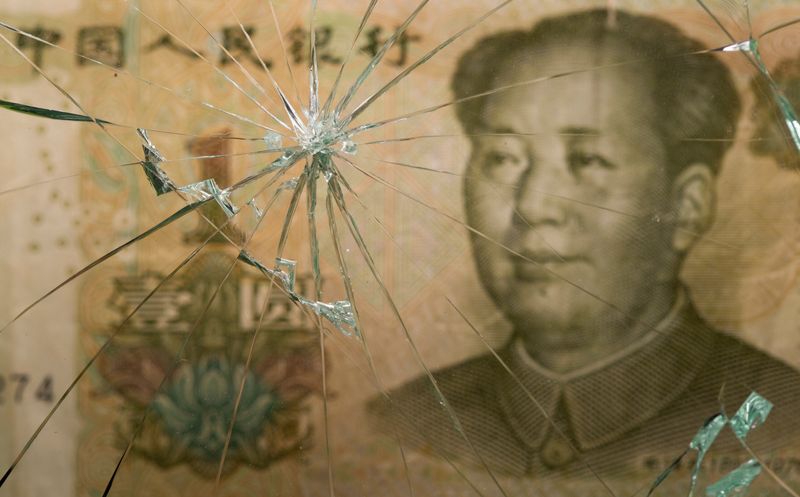Forex
Factbox-Policy measures China’s central bank could use to stem yuan weakness


© Reuters. Chinese yuan banknote is pictured through broken glass in this illustration taken June 25, 2021. REUTERS/Dado Ruvic/Illustration
(Reuters) – China has ramped up its effort to slow the depreciation of the against the dollar this week and market participants widely believe that the People’s Bank of China (PBOC) may follow up with more policy measures if the weakness persists.
The PBOC set stronger-than-expected midpoint fixing rates this week and state banks were spotted selling dollars a few times in both onshore and offshore markets, sources said, in the strongest sign yet authorities are growing increasingly uncomfortable with the yuan’s quickening slide.
The yuan has lost nearly 5% to the dollar this year, becoming one of the worst-performing Asian currencies. [CNY/]
Following is a list of policy moves and measures by the PBOC to curb excess yuan volatility over the past few years:
** COUNTER-CYCLICAL FACTOR IN DAILY YUAN FIXING FORMULA
The PBOC first added the counter-cyclical factor to its formula for fixing the daily midpoint for the yuan-dollar exchange rate in 2017.
The central bank never disclosed how it calculated the counter-cyclical factor but regulators described it as a way to better reflect fundamental supply and demand and lessen the effect of herd mentality in the currency market.
** DAILY MIDPOINT SETTING
The onshore spot yuan can trade in a 2% range around the midpoint set by the PBOC in the daily fix.
Currency traders regard any significant discrepancy between market projections of what the fix might be and where the PBOC actually sets the midpoint as an indication of which way the central bank wants to nudge the market.
** STATE BANK ACTIONS
China’s major state-owned banks have recently been spotted selling dollars and, although they have their own orders to execute, it was assumed they were acting at the behest of the PBOC, sources told Reuters.
State banks were also seen swapping yuan for dollars in forwards and immediately selling them into the spot market to prop up the currency during previous rounds of depreciation.
** VERBAL MESSAGES
Senior officials from the central bank and foreign exchange regulator have used public speeches and commentaries in state media to send messages to the currency market, usually reiterating a pledge to keep the yuan basically stable.
The PBOC said in mid-May that China would resolutely curb large fluctuations in the exchange rate and study the strengthening of self-regulation of dollar deposits.
Weeks later, sources told Reuters that a self-regulatory body overseen by the central bank had told major state-owned banks to lower dollar deposit interest rates and bolster the yuan.
** HIGHER DERIVATIVE TRADING COST
In September 2022, the PBOC made it more expensive for financial institutions to short the yuan in derivative markets, by raising their foreign exchange risk reserve ratio to 20% from zero.
** HIGHER ONSHORE DOLLAR LIQUIDITY
The PBOC has previously cut the amount of foreign exchange that financial institutions need to hold as reserves to make it less expensive for them to hold dollars.
It last cut the foreign exchange reserve requirement ratio for financial institutions to 6% from 8% in September 2022 to slow yuan depreciation.
** TIGHTER OFFSHORE YUAN LIQUIDITY
To reduce yuan liquidity , the PBOC issued more yuan-denominated bills in Hong Kong.
While the amounts were small, analysts said they sent a clear message guiding expectations for the yuan exchange rate.

 Forex3 years ago
Forex3 years agoForex Today: the dollar is gaining strength amid gloomy sentiment at the start of the Fed’s week

 Forex3 years ago
Forex3 years agoUnbiased review of Pocket Option broker

 Forex3 years ago
Forex3 years agoDollar to pound sterling exchange rate today: Pound plummeted to its lowest since 1985

 Forex3 years ago
Forex3 years agoHow is the Australian dollar doing today?

 Cryptocurrency3 years ago
Cryptocurrency3 years agoWhat happened in the crypto market – current events today

 World3 years ago
World3 years agoWhy are modern video games an art form?

 Commodities3 years ago
Commodities3 years agoCopper continues to fall in price on expectations of lower demand in China

 Economy3 years ago
Economy3 years agoCrude oil tankers double in price due to EU anti-Russian sanctions























